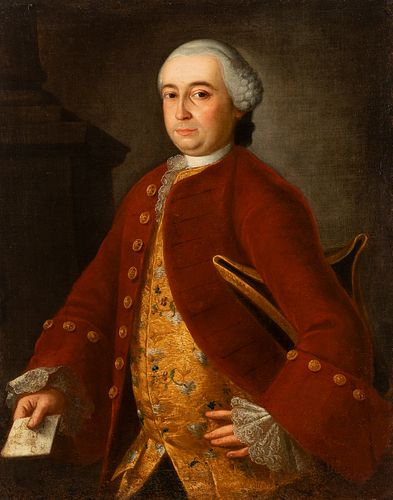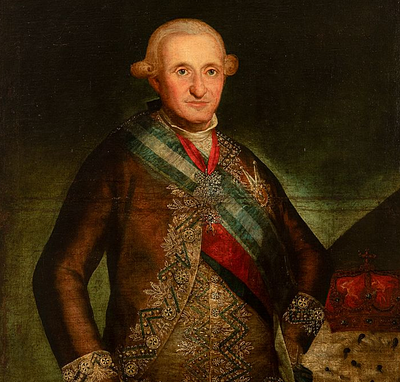Spanish school; circa 1760- 1770. "Portrait of a gentleman. Oil on canvas. Relined
Lot 33
About Seller
Setdart Auction House
Carrer Aragó 346
Barcelona
Spain
Setdart Subastas was born in 2004 and is currently the first online art auction in Spain with solidity, prestige and reliability guaranteed by our more than 60,000 users. Setdart has a young, dynamic and enterprising team ready to successfully manage the purchase and sale of art works through custom...Read more
Estimate:
EUR€3,000 - EUR€4,000
$3,092.78 - $4,123.71
Absentee vs Live bid
Two ways to bid:
- Leave a max absentee bid and the platform will bid on your behalf up to your maximum bid during the live auction.
- Bid live during the auction and your bids will be submitted real-time to the auctioneer.
Bid Increments
| Price | Bid Increment |
|---|---|
| EUR€0 | EUR€10 |
| EUR€200 | EUR€25 |
| EUR€500 | EUR€50 |
| EUR€1,000 | EUR€100 |
| EUR€3,000 | EUR€200 |
| EUR€5,000 | EUR€500 |
| EUR€10,000 | EUR€1,000 |
| EUR€20,000 | EUR€2,000 |
| EUR€50,000 | EUR€5,000 |
About Auction
By Setdart Auction House
Sep 22, 2021
Set Reminder
2021-09-22 09:30:00
2021-09-22 09:30:00
America/New_York
Bidsquare
Bidsquare : 22nd September - ARAS JÁUREGUI Private Collection - Old Masters, 19th & 20th Century
https://www.bidsquare.com/auctions/setdart-auction-house/22nd-september---aras-j-uregui-private-collection---old-masters-19th-20th-century-7427
ARAS JÁUREGUI Private Collection - Old Masters, 19th & 20th Century Setdart Auction House sofia@setdart.com
ARAS JÁUREGUI Private Collection - Old Masters, 19th & 20th Century Setdart Auction House sofia@setdart.com
- Lot Description
Spanish school; circa 1760- 1770. "Portrait of a gentleman. Oil on canvas. Relined It presents faults, repainting and illegible inscription. Measurements: 105 x 82 cm. The author conceives with this work a three-quarter portrait of a standing man turned a quarter to the right of the spectator. His right hand rests on his hip, while his left hand is stretched out in front of him, showing the viewer a parchment, or a sheet of paper on which an inscription can be seen. The subject wears a powdered wig, a dark red collarless coat with gold-coloured buttons, and a waistcoat extensively decorated with gold embroidery. Under his arm a tricorn-shaped cap is visible, showing his connection with the military profession. The work is largely reminiscent of the work executed in 1736 by the painter Charles Bridges (England 1672 - 1747), which portrays Alexander Spotswood, a British army officer, explorer and lieutenant governor of colonial Virginia, considered one of the most important figures in British-colonised North America. In both cases the figures wear this type of red buttoned jacket, even on the sleeves, so it is likely that the person in the portrait, although his identity is unknown, is a military officer linked to the British crown. They were known in some cases by the nickname "the redcoats", due to the colour of the battle dress and ceremonial uniform. The uniform was designed to distinguish them easily from other combatants, to instil fear and to cover the blood of wounds, implying that they were an almost immortal army. The uniform was long worn by the colonial regiments of the so-called United Kingdom of Great Britain. During the 17th and 18th centuries, the British East India Trading Company had permission from the empire to recruit private armies, which wore red coats. Since the company was then so powerful that it had its own currency and had great influence on the economy of England and the New World, the British Empire adopted the uniform as a badge of its power. As in the rest of Europe, portraiture became the genre that gained most prominence due to the excellence of Spanish painting as a result of the new social structures that were established in the Western world during this century, embodying the ultimate expression of the transformation in the taste and mentality of the new clientele that emerged among the nobility and the wealthy gentry, who were to take the reins of history in this period. While official circles gave precedence to other artistic genres, such as history painting, and the incipient collectors encouraged the profusion of genre paintings, portraiture was in great demand for paintings intended for the more private sphere, as a reflection of the value of the individual in the new society. This genre embodies the permanent presence of the image of its protagonists, to be enjoyed in the privacy of a studio, in the everyday warmth of a family cabinet or presiding over the main rooms of the house.
- Shipping Info
-
In-house shipping available. Please inquire at admin@setdart.com.
-
- Buyer's Premium



 EUR
EUR CAD
CAD AUD
AUD GBP
GBP MXN
MXN HKD
HKD CNY
CNY MYR
MYR SEK
SEK SGD
SGD CHF
CHF THB
THB
















